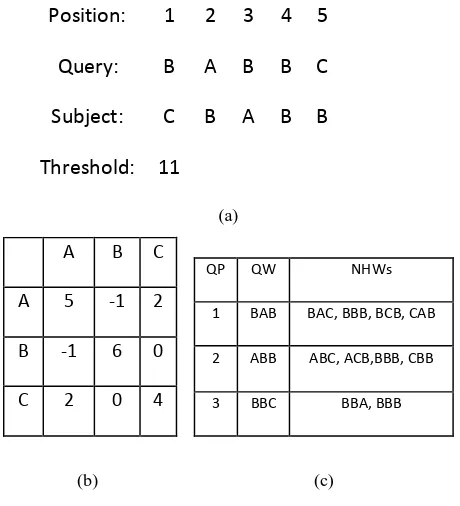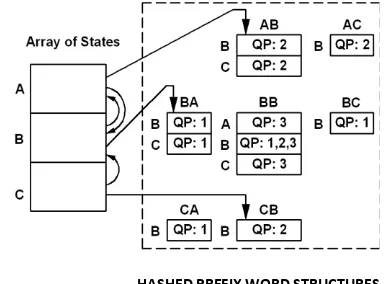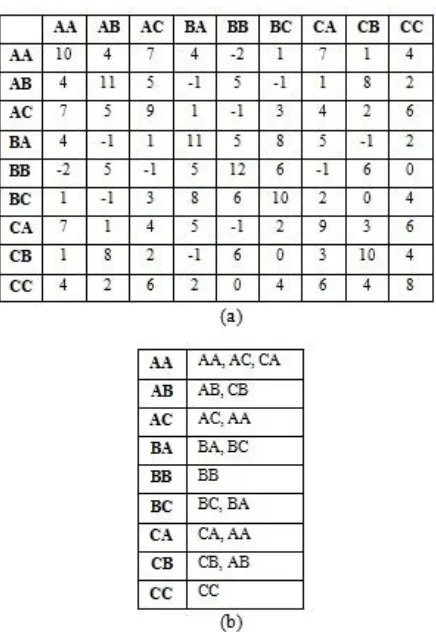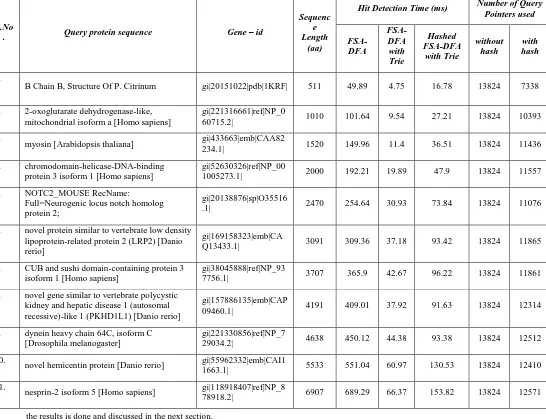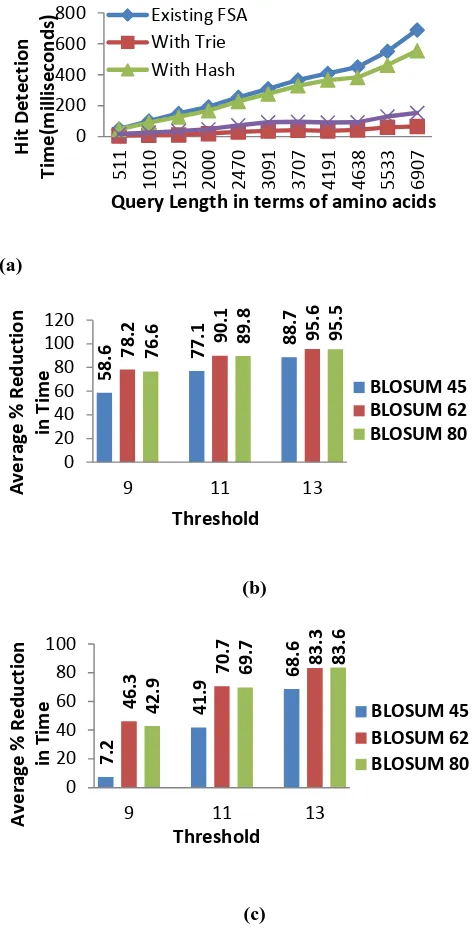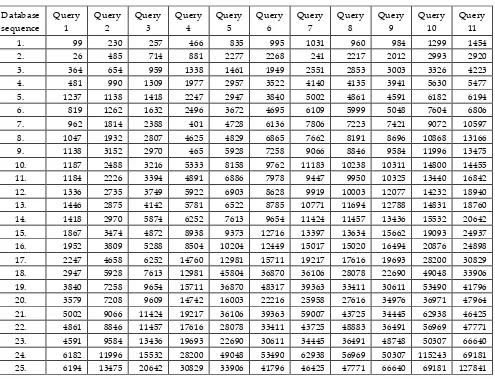BLOSUM Trie for Faster Hit Detection
in FSA Protein BLAST
M Anuradha
Research scholar Department of Computer
Science & Systems Engineering, Andhra University
Visakhapatnam - 530 003
K Suman Nelson
Software Engineer Google India
Hyderabad
P V G D Prasad Reddy
Professor Department of Computer
Science & Systems Engineering, Andhra University
Visakhapatnam - 530 003
ABSTRACT
Basic Local Alignment Search Tool (BLAST) is one of the most widely used bioinformatics tools to determine similarities between genomic sequences. Ever since its inception several algorithmic improvements have been made to improve speed and runtime memory requirements without affecting the sensitivity and selectivity of the tool. Fast search algorithm (FSA) BLAST has been the most successful among such improvements with 20-30% faster processing rate. A DFA with hashed prefix word structures for the hit detection process in FSA BLAST has been proposed in the earlier work. Coding of the algorithms and testing on protein samples showed that the use of the new structure resulted in significant reduction in run time space but not the hit detection time. This paper proposes the use of a BLOSUM trie structure which eliminates the process of computing neighborhood words, resulted in a reduction of up to 75% in hit detection time. Tests were conducted with different BLOSUM matrices and threshold values and the proposed algorithm was found to be beneficial in terms of space, time complexity and accuracy without compromising on sensitivity and selectivity of the currently being used algorithm.
General Terms
Sequence Analysis, Protein BLAST, Hit Detection Algorithm, Time Complexity, Space Complexity, Sensitivity and Selectivity.
Keywords
Deterministic finite automaton, prefix word table neighborhood words, query pointers, hits and BLOSUM Trie.
1.
INTRODUCTION
Basic local alignment search tool (BLAST) is the most widely used sequence similarity search tool used by computational biologists to understand the role, structure and function of genomic sequences. BLAST performs comparisons between a pair of sequences in order to find regions of local similarity [1]. The popular BLAST derivatives are NCBI-BLAST (web based and standalone versions are available), WU-BLAST, Paracel BLAST and fast search algorithm (FSA)-BLAST [2, 3, 4, 5, 6, 7]. Among them, NCBI-BLAST (standalone) and FSA-BLAST are open source programs and any one can download
(ftp://ftp.ncbi.nlm.nih.gov/blast/executables/blast+/Latest, http://www.fsa-blast.org ) and experiment with the program code and algorithms.
Because of its widespread usage (used over 120,000 times each day) and exponential growth in genomic databases,
BLAST is becoming slower [8, 9]. In view of the above reasons, any improvement to the BLAST algorithm that can reduce runtime space and time without effecting sensitivity and selectivity would be very much desirable [10].
Over the years several modifications to the fundamental algorithms and new heuristics in BLAST were proposed to improve speed and minimize runtime space [3-7], [11-18]. Basically, BLAST program was designed to analyze both protein and DNA sequences. It has mainly four algorithmic steps namely finding hits, performing un-gapped alignments, performing gapped alignments and computing trace back and outputting the results [2, 3, 6, 7]. The main functional differences between NCBI BLAST and FSA BLAST are, one is the structure used for finding hits between a query sequence and database sequence during the hit detection process and the other is using semi-gapped and restricted insertion alignments during alignment stage of the algorithm [6,7]. A modified DFA proposed in the earlier work, reduced the runtime space significantly during the hit detection stage of the FSA protein BLAST algorithm [19]. But reduction in hit detection time is not significant. This paper proposes a method that eliminates the process of computing neighborhood words during hit detection process. It resulted in significant reduction in hit detection time of FSA protein BLAST algorithm.
Hits are short, fixed length high scoring matches between query sequence and database sequence. For protein search, hit is a match of word length 3 and inexact matches are permitted whereas for nucleotide search, hit is an exact match of word length 11. For finding hits, FSA-BLAST used an optimized deterministic finite automaton (DFA) which reduced the total BLAST search time by 6 to 30% compared with table look-up used in NCBI BLAST[3,7]. But study on this implementation revealed that, the number of query pointers used by the structure is fixed and dependent on alphabet size (a) and word length (w), and is equal to ‘aw
‘(for protein sequence, a=24 and w=3), i.e., 243=13,824, not on the length of the query. In the modified structure, it is made dependent on length of query sequence and the number of neighborhood words to each query word. This reduces the run time space of algorithm by a considerable amount, by initializing only the necessary query pointers [19].
Results are analyzed and discussed in Section 5. Conclusions are given in section 6 and acknowledgements in section 7.
2.
HIT DETECTION PROCESS
In this stage, BLAST compares query sequence with each sequence of the database using Wilbur and Lipmann algorithm [20]. This process is done in two steps; one is structure construction which is unique for a query, and second is processing the database sequence to find word matches between query sequence and database sequence.
During the structure construction, fixed length overlapping words of length ‘w’ are extracted from the query sequence. For example, let ‘BABBC’ be the query sequence made up of an alphabet: {A, B, C} and w=3, then the fixed length overlapped words extracted from the query are: BAB, ABB, and BBC. For each query word, neighborhood words of length ‘w’ are generated. A neighborhood word is a word obtaining a score greater than or equal to some threshold value ‘T’ (default values used by NCBI-BLAST for protein search are T=11 and w=3) [21-24], using a selected scoring matrix. For example for query word BAB, BAC is neighborhood word. When B is matched with B, score is 6, when A is matched with A, score is 5 and when C is matched with B, score is 0. Then the word score is sum of the individual scores and given below.
[image:2.595.314.544.189.442.2] [image:2.595.94.505.568.724.2]B A B | | |
B A C 6+5+0=11 which is equal to T. The default scoring matrix used for protein BLAST is BLOSUM62 [25]. Each query word along with its neighborhood words will be associated with a query position and are stored in a structure. In the above example, query positions of query words BAB, ABB, and BBC are 1, 2, and 3 respectively.
While processing the database sequences, each sequence is processed sequentially, that is each sequence is read from the database, parsed into words of length ‘w’ and searched for
query word match in the structure. If a match is found, corresponding query word position ‘i’ and database sequence word position ‘j’ are recorded as hit, which will be the input to the alignment stage of the BLAST algorithm.
3.
STRUCTURES USED FOR FINDING
HITS
3.1
Existing FSA-DFA Structure
FSA-DFA consists of states, and transitions between the states. A state is a prefix word of length (w-2). The total number of states is equal to a(w-2) (24 for a protein sequence). FSA-DFA shown in Figure.2 for an input given in Figure.1 is constructed as follows.
Position:
1
2
3 4 5
Query:
B
A B B C
Subject:
C
B A B B
Threshold: 11
(a)
A B C
A 5 -1 2
B -1 6 0
C 2 0 4
(b)
QP QW NHWs
1 BAB BAC, BBB, BCB, CAB
2 ABB ABC, ACB,BBB, CBB
3 BBC BBA, BBB
(c)
Figure 1: (a) Example Query and Database sequences constructed with an alphabet:{A,B,C};word length(w)=3 (b) Scoring Matrix (c) List of query words(QW) and their neighborhood words (NHWs) along with their query positions (QP) for the given query
a(w-2) states are initialized in such a way that each state consists of ‘a’ transitions and each transition is associated with two pointers, one to the next state and other to a collection of words that share common prefix of length ‘(w-1)’. Each word in the prefix table is associated with a query pointer pointing to a list of query positions which is initially initialized to NULL.
For each query word, neighborhood words given in Figure 1(c) are computed based on the given threshold T using alignment scoring matrix, and their query positions are stored in the structure. For the given example, structure consists of 3 states A, B and C. Each state consists of 3 transitions A, B and C, and each transition is associated with corresponding prefix table. For a given query, we start with word BAB. Transition A of state B has pointer to next state A and pointer to prefix word table BA. In the prefix word table, for the word BAB, the query position is marked as 1 because it is available in query sequence at position 1. The neighborhood words to BAB, listed in fig 1(c), are now computed and their positions are also stored in the structure. This process repeats for every query word.
While processing the database sequence ‘CBABB’, the first character ‘C’ is read. That is we are starting with the state C. Then the next character ‘B’ is read, transition ‘B’ from state C is followed. Here transition B of state C has, one pointer to next state B and other pointer to prefix table of word CB. Since the next character read is A, and for the word CBA there is no match in the query sequence the search advances to next state B. Now we are at state B, and next character read is A, then transition A from state B is followed which has pointers to next state A and prefix word table BA. When the next character B is read, transition ‘B’ from prefix table ‘BA’ is followed. Here the transition has a query position 1, hence outputs the hit as (1, 2), i.e., match occurs at query position ‘1’ and database sequence position ‘2’ and search advances to next state ‘A’. This process continues until the data base sequence is exhausted.
3.2
FSA-DFA with hashed prefix word
structures
The limitation of currently being used FSA-DFA is, whatever may be the query length, size of the DFA and the number of query pointers initialized during the structure construction stage is fixed (aw). For a protein sequence, it is equal to 243=13,824. Indeed, for a given query we may not be using these many pointers. Whether we use or not, 4 bytes of memory is allocated to each pointer which will be a considerable overhead on run-time space utilization. It can be overcome by using an array of states and prefix word hash table which makes the number of query pointers to be initialized dependent on the size of query and the number of neighborhood words each query word is associated with, instead of initializing fixed number of pointers. This section presents construction of such structure with an example and is explained below.
It consists of array of states, where each state is a word block of (w-2) length. The size of the array is equal to a(w-2) (24 for a protein sequence). Each state is associated with a hashed prefix word table with query or neighborhood word as key and pointer to list of query positions as value. Initially the size
of each hash table is zero and it grows by one key and one value for each query word and its neighborhood words, while constructing FSA-DFA.
A portion of the modified FSA-DFA shown in Figure.3, for the given query sequence ‘BABBC’ is constructed as follows. Let the query word be ‘w1w2w3’. For each query word, w1 is the current state, w2 is the next state and w3 is the transition that maps query word w1w2w3 from current state into corresponding query position in prefix word hash table w1w2. In this example, for query word ‘BAB’, B is the current state, A is next state and B is the transition that maps query word BAB into query position 1 in prefix word hash table BA. Similarly neighborhood words to word BAB are also mapped into query position 1. Similarly the remaining query words, ABB and BBC, and their neighborhood words are also mapped into their corresponding query positions in corresponding prefix word hash tables. So whenever a query word or neighborhood word is mapped into corresponding query position, two pointers are initialized. One maps into the hash table of that state and other to the next state. Hence the number of query pointers initialized is less than or equal to the sum of the number of query words and their neighborhood words.
The database sequence ‘CBABB’ is processed as follows. When the first character ‘C’ is read, we are starting with state C. Then the next character ‘B’ is read, a pointer to next state B is followed. When next character ‘A’ is read, since there is no match for the word CBA in the query, search advances to next state B. At state B, a pointer to next state A and other to the prefix word hash table BA of state B is followed. When the next character B is read, word BAB will be hashed into slot B of prefix word hash table ‘BA’ of state B and outputs a hit (1, 2). Now we are at state A. when character B is read a pointer to next state B and other to the prefix word hash table AB of state A is followed. When the next Character B is read, word ABB is hashed into slot B of prefix word hash table AB of state A (where match is found for the word ABB in the query sequence at position 2, that outputs a hit (2, 3)). The process continues until the data base sequence is exhausted.
3.3
BLOSUM trie structure
Finding neighborhood words to each query word during the structure initialization stage is most time consuming because each word needs to be compared with aw words where each
HASHED PREFIX WORD STRUCTURES
[image:3.595.324.516.334.476.2]query word will be having very few neighborhood words out of aw words and the process repeats for every query. Cost of finding neighborhood words can be reduced by using a BLOSUM trie structure consisting of pre-computed lists of neighborhood words to each possible word of length ‘w’ for a given alphabet and scoring matrix. This section presents construction of such structures with an example.
Let ‘Q’ be set of query words where qi is query word available at ith position of query sequence, ‘Qi’ be the set of neighborhood words to query word qiand ‘S’ be the set of all possible words of fixed length w with the given alphabet of size ‘a’. Let n(Qi) and n(S) are number of elements in the sets Qi and S respectively where n(S)=a
w
. For any query, Q is a proper subset of S and n(Qi) is very small when compared with n(S). For a specific scoring matrix if we compute the set of neighborhood words to each word in S once, they can be reused for all query words and any number of queries. By taking the above facts into consideration a BLOSUM trie is constructed as follows.
• For the scoring matrix given in Figure 1(b), alphabet: {A, B, C} and word length w=2, the word matrix ‘W’ of size (aw
x aw) (9x9 in this example) is computed in such a way that the element wij of W is the score when the word in ith row is matched with the word in jth column.
• The lists of neighborhood words (words with wij ≥ T) to each word in S are extracted from W and are arranged in descending order as shown in the Figure 4(a) and (b).
Figure 4: (a) Pre-computed word matrix consisting of scores of all possible words of size w=2, obtained using alphabet: {A, B, C} and the scoring matrix given in Fig. 1 (b) Lists of neighborhood words to each possible word of size w=2 and word score ≥7 obtained from pre-computed word matrix
The lists of neighborhood words to each word in S are stored as a trie structure because trie is more space efficient, particularly when there is large number of known short length keys. Another advantage of trie structure is, searching and data retrieval is faster (of order of O(w)). Trie structure for the lists given in Figure 3(b) is shown in Figure 4. It is implemented as non-binary search tree, where each node contains at most ‘a’ pointers, corresponding to ‘a’ possible characters in each position of the word except leaf nodes. The root node corresponds to an empty string whereas the other nodes correspond to prefixes of words in S. Each path from root to a leaf corresponds to one word in S.
• The neighborhood words to each word in S are extracted from the trie by traversing from root node with the prefix of word, to a node where the word ends. All the leaf nodes under that node are nothing but the set of neighborhood words including the word itself.
4.
TESTING
[image:4.595.305.561.266.377.2] [image:4.595.58.276.377.693.2]Table 1. Comparison of hit detection time and number of query pointers used in FSA-DFA using trie and hashed FSA-DFA using trie with FSA-DFA for BLOSUM 62 scoring matrix and T=11
the results is done and discussed in the next section.
5.
RESULT ANALYSIS
5.1
Quantitative Analysis
5.1.1
Space complexity
The number of query pointers initialized during structure construction is taken as measuring factor for space complexity. For a small set of query sequences, the results are tabulated in Table 1 given above.
From the results we can see that, the number of query pointers initialized in the existing FSA DFA structure is fixed and is maximum possible. It is dependent on alphabet size ‘a’ (24 for proteins) and word size ‘w’ (3 for proteins), i.e., 243=13,824 whereas for the proposed structures it is made dependent on size of the query sequence and the number of neighborhood words, each query word has. It is found that the reduction in space is significant and varied based on threshold, BLOSUM and query length. For larger threshold, higher BLOSUM and shorter query, the reduction in space is more. Test results are
tabulated in Table 2 and graphically represented in Figure 6 given below.
Table 2. Space efficiency of hashed FSA-DFA as a function of T and BLOSUM scoring matrix
Threshold (T)
Average Reduction in Memory Space (bytes)
BLOSUM 45 BLOSUM 62 BLOSUM 80
9 2027 5925 4523
11 6136 15226 12051
13 13920 29662 24851
S.No
. Query protein sequence Gene – id
Sequenc e Length
(aa)
Hit Detection Time (ms) Number of Query
Pointers used
FSA-DFA
FSA-DFA with Trie
Hashed FSA-DFA
with Trie
without hash
with hash
1.
B Chain B, Structure Of P. Citrinum gi|20151022|pdb|1KRF| 511 49.89 4.75 16.78 13824 7338
2. 2-oxoglutarate dehydrogenase-like, mitochondrial isoform a [Homo sapiens]
gi|221316661|ref|NP_0
60715.2| 1010 101.64 9.54 27.21 13824 10393
3.
myosin [Arabidopsis thaliana] gi|433663|emb|CAA82
234.1| 1520 149.96 11.4 36.51 13824 11436
4. chromodomain-helicase-DNA-binding protein 3 isoform 1 [Homo sapiens]
gi|52630326|ref|NP_00
1005273.1| 2000 192.21 19.89 47.9 13824 11557
5. NOTC2_MOUSE RecName:
Full=Neurogenic locus notch homolog protein 2;
gi|20138876|sp|O35516
.1| 2470 254.64 30.93 73.84 13824 11076
6. novel protein similar to vertebrate low density lipoprotein-related protein 2 (LRP2) [Danio rerio]
gi|169158323|emb|CA
Q13433.1| 3091 309.36 37.18 93.42 13824 11865
7. CUB and sushi domain-containing protein 3 isoform 1 [Homo sapiens]
gi|38045888|ref|NP_93
7756.1| 3707 365.9 42.67 96.22 13824 11861
8. novel gene similar to vertebrate polycystic kidney and hepatic disease 1 (autosomal recessive)-like 1 (PKHD1L1) [Danio rerio]
gi|157886135|emb|CAP
09460.1| 4191 409.01 37.92 91.63 13824 12314
9. dynein heavy chain 64C, isoform C [Drosophila melanogaster]
gi|221330856|ref|NP_7
29034.2| 4638 450.12 44.38 93.38 13824 12512
10.
novel hemicentin protein [Danio rerio] gi|55962332|emb|CAI1
1663.1| 5533 551.04 60.97 130.53 13824 12410
11.
nesprin-2 isoform 5 [Homo sapiens] gi|118918407|ref|NP_8
5.1.2
Time complexity
Time complexity of modified structure with the currently being used structure is compared as follows. Performance counter has been set separately to measure the structure construction time for the given query and time for processing the database sequence for finding hits. The least time unit that can be measured by the performance counter is millisecond. For better accuracy, processing of database sequences has been set to run 10 times. It is observed that there is slight increase in processing database sequence time due to hashing function used to map the database sequence word into corresponding query position during the processing stage. But there is drastic improvement in structure initialization time due to modified structure and usage of trie to find the neighborhood words. Percentage reduction in overall time for finding hits using modified structure is calculated for a set of query sequences. The results are graphically represented in Figure 7 given below.
5.2
Qualitative Analysis
BLAST performs similarity search which can be improved either by increasing sensitivity or selectivity. Sensitivity of BLAST is defined as ability to recognize distantly related data base sequences to that of a query sequence. Selectivity is defined as ability to reject unrelated database sequences to
(a)
(b)
(c)
Figure 7: Graphical representation of (a) performance (time) of FSA-DFA and Hashed FSA-DFA with and without Trie using BLOSUM 62 and T=11 (b) Average percentage reduction in hit detection time of FSA-DFA using Trie (c) Average percentage reduction in hit detection time of Hashed FSA-DFA using Trie.
that of a query sequence. The number of alignments being considered in the second stage of the BLAST is dependent on the number of hits generated in the first stage of the BLAST. For example, for a query of length 110 amino acids, the number of hits recorded for both existing structures and proposed structures is 984, when run on the database sequence of length 48748 amino acids. In the alignment stage, the scores of all 984 alignments are computed and best scored alignments will be taken into account for final output of BLAST. The experimental results tabulated in Table 3 given below reveals that the number of hits recorded for FSA-DFA and modified structures are similar. Hence we can say that, space and time complexity of the algorithm is reduced without effecting sensitivity and selectivity.
0 200 400 600 800
511 1010 1520 2000 2470 3091 3707 4191 4638 5533 6907
H
it
D
et
e
ct
io
n
Ti
m
e(
m
ill
ise
con
ds
)
Query Length in terms of amino acids
Existing FSAWith Trie With Hash
58.6
77.1 88.7
78.2 76.6 90.1 89.8 95.6 95.5
0 20 40 60 80 100 120
9 11 13
A
ve
ra
ge
% R
e
du
ct
io
n
in
T
im
e
Threshold
BLOSUM 45 BLOSUM 62 BLOSUM 80 7.2 41.9 68.6 46.3 70.7 83.3 42.9 69.7 83.6 0 20 40 60 80 1009 11 13
A
ve
ra
ge
%
R
ed
u
ct
io
n
in
Ti
m
e
Threshold
BLOSUM 45 BLOSUM 62 BLOSUM 80 (a) (b)Figure 6: Graphical representation of (a) Hashed FSA-DFA performance (space) with BLOSUM 62 and T=11 in terms of query pointers (b) Average reduction in memory space in terms of bytes when Hashed FSA-DFA is used
0 5000 10000 15000
511 1010 1520 2000 2470 3091 3707 4191 4638 5533 6907
Numbe
r
o
f
Q
ue
ry
po
inter
s
U
se
d
Query Length in terms of amino acids
Without Hash 2027 6136 13920 5925 15226 29662 4523 12051 24851 0 5000 10000 15000 20000 25000 30000 350009 11 13
[image:6.595.57.299.73.425.2] [image:6.595.316.553.75.541.2]Table 3: Number of hits recorded when each query sequence is searched against the database using FSA-DFA and hashed FSA-DFA with and without trie for BLOSUM 62 scoring matrix and T=11
6.
CONCLUSIONS
An alternative data structure for FSA DFA and a trie structure in place of BLOSUM62 matrix, during the structure construction stage have been successfully implemented and tested. It is concluded that:
• Use of the new data structure resulted in significant reduction in runtime space. For smaller query lengths (110 aa) the reduction in run time space was found to be up to 78.7%, for very large query length (6907 aa) it is about 9.1% using a threshold of 11 and BLOSUM 62 scoring matrix.
• Use of trie in place of BLOSUM62 reduced the hit detection time very significantly. Percentage reduction in hit detection time was found to be directly proportional to the query length, i.e., as the query length increases the percentage reduction in hit detection time also increases.
• Use of trie also improves the accuracy of BLAST output. In the existing implementation, the number of neighborhood
words to each query word to be taken into account is limited to ~50 on the first come first serve basis (if it exceeds50), whereas trie structure consists of the best 50 words
words (since trie is constructed from pre-computed lists of neighborhood words arranged in descending order according to word score when compared with T).
• The number of hits detected remained the same for both FSA DFA and hashed FSA DFA, with and without trie for a specific BLOSUM matrix and threshold. It indicates that the use of hashed FSA DFA and trie did not alter the sensitivity and selectivity of the BLAST tool.
• The data structures proposed in this work can be of use for stand-alone BLAST as well as web based one.
The above said improvements can be incorporated into FSA BLAST and the overall reduction in run time space utilization as well as time can be tested on real time databases.
This work focuses only on improving run time space and reducing hit detection time of the structure construction stage. While scanning the database, the number of hits is known when a specific query is compared with each sequence of the database. This information can be used to filter some of the database sequences that have negligible number of hits from being used in alignment stage.
Database sequence
Query 1
Query 2
Query 3
Query 4
Query 5
Query 6
Query 7
Query 8
Query 9
Query 10
Query 11
1. 99 230 257 466 835 995 1031 960 984 1299 1454
2. 26 485 714 881 2277 2268 241 2217 2012 2993 2920
3. 364 654 959 1338 1461 1949 2551 2853 3003 3326 4223
4. 481 990 1309 1977 2957 3522 4140 4135 3941 5630 5477
5. 1237 1138 1418 2247 2947 3840 5002 4861 4591 6182 6194
6. 819 1262 1632 2496 3672 4695 6109 5999 5048 7604 6806
7. 962 1814 2388 401 4728 6136 7806 7223 7421 9072 10597
8. 1047 1932 2807 4625 4829 6865 7662 8191 8696 10868 13166
9. 1138 3152 2970 465 5928 7258 9066 8846 9584 11996 13475
10. 1187 2488 3216 5333 8158 9762 11183 10238 10311 14800 14455
11. 1184 2226 3394 4891 6886 7978 9447 9950 10325 13440 16842
12. 1336 2735 3749 5922 6903 8628 9919 10003 12077 14232 18940
13. 1446 2875 4142 5781 6522 8785 10771 11694 12788 14831 18760
14. 1418 2970 5874 6252 7613 9654 11424 11457 13436 15532 20642
15. 1867 3474 4872 8938 9373 12716 13397 13634 15662 19093 24937
16. 1952 3809 5288 8504 10204 12449 15017 15020 16494 20876 24898
17. 2247 4658 6252 14760 12981 15711 19217 17616 19693 28200 30829
18. 2947 5928 7613 12981 45804 36870 36106 28078 22690 49048 33906
19. 3840 7258 9654 15711 36870 48317 39363 33411 30611 53490 41796
20. 3579 7208 9609 14742 16003 22216 25958 27616 34976 36971 47964
21. 5002 9066 11424 19217 36106 39363 59007 43725 34445 62938 46425
22. 4861 8846 11457 17616 28078 33411 43725 48883 36491 56969 47771
23. 4591 9584 13436 19693 22690 30611 34445 36491 48748 50307 66640
24. 6182 11996 15532 28200 49048 53490 62938 56969 50307 115243 69181
25. 6194 13475 20642 30829 33906 41796 46425 47771 66640 69181 127841
Pre-computed word matrices require more memory than the BLOSUM matrices. This can be overcome by creating a database of tries for all BLOSUM matrices and giving it as one of the input to the BLAST tool.
7.
ACKNOWEDGEMENTS
This research work is done independently and is part of Ph.D work. It is not supported by any funding body.
8.
REFERENCES
[1] Pertsemlidis, A. and John, W. Fondon III. 2001. Tutorial - Having BLAST with bioinformatics (and avoiding BLASTphemy), Genome Biology 2(10). [2] Altschul, S. F. Gish, W. Miller, W. Myers, E. W. and
D.J. Lipman, D. J. 1990. Basic local alignment search tool. Journal of Molecular Biology, 215(3):403– 410. [3] Altschul, S. F. Madden, T. L. Schaffer, A. A. Zhang, J.
Zhang, Miller, Z. W. and D.J. Lipman, D. J. 1997. Gapped BLAST and PSI–BLAST: A new generation of protein database search programs. Nucleic Acids Research, 25(17):3389–3402.
[4] WU-BLAST [http://blast.wustl.edu/]
[5] Boysen, C. and Marc, A. Rieffel. 2004. Enhancing BLAST Performance by using paracel filtering package, Paracel Technology.
[6] Cameron, M.. Williams, H. E. and Cannane, A. 2004. Improved gapped alignment in BLAST. IEEE Transactions on Computational Biology and Bioinformatics, 1(3):116-129.
[7] Cameron, M.. Williams, H. E. and Cannane, A. 2006. A deterministic finite automaton for faster protein hit detection in BLAST, Journal of Computational Biology 13(4), 965–978.
[8] McGinnis, S. and T.L. Madden, T. L. 2004. BLAST: at the core of a powerful and diverse set of sequence analysis tools. Nucleic Acids Research, 32:W20–W25. [9] Chen, X. L. 2004. personal communication.
[10]Shapaer, E. G. Robinson, M. Yee, D. Candlin, J. D. Mines, R. and Hunkapiller, T. 1996. Sensitivity and selectivity in protein similarity searches: A Comparison of Smith-Waterman in Hardware to BLAST and FASTA. Genomics,38, 179-191.
[11]Gotoh, O. 1982. An improved algorithm for matching biological sequences. Journal of Molecular Biology, 162(3):705–708.
[12]Jian, Y. McGinnis, S. and Madden, T. L. 2006. BLAST: improvements for better sequence analysis, W6–W9 Nucleic Acids Research, Vol. 34, Web Server issue doi:10.1093/nar/gkl164
[13]Noé,* L. and Kucherov, G. 2004. Improved hit criteria for DNA local alignment, BMC Bioinformatics, 5:149 doi:10.1186/1471-2105-5-149.
[14]Delaney, S. Butler, G. Lam, C. and Thiel, L. Three Improvements to the BLASTP Search of Genome Databases, 0-7695-0686-0/00 $10.00 _ 2000 IEEE [15]Cameron, M. and Williams, H. E. 2007. Comparing
Compressed Sequences for Faster Nucleotide BLAST Searches, IEEE Transactions.
[16]Afratis, P. Galanakis, C. Sotiriades, E. Mplemenos, G. G. Chrysos, G. Papaefstathiou, I. and Pnevmatikatos, D. Design and Implementation of a Database Filter for BLAST Acceleration, 978-3-9810801-5-5/DATE09 © 2009 EDAA.
[17]Guo, X. Wang, H. Vijay, D. Design of a FPGA-Based Parallel Architecture for BLAST Algorithm with Multi-hits Detection, 2011 Eighth International Conference on Information Technology: New Generations, 978-0-7695-4367-3/11 $26.00 © 2011 IEEE, DOI 10.1109/ITNG.2011.122.
[18]Boratyn, G. M. Schaffer, A. A. Agarwala, R. Altschul, S. F. Lipman, D. J. and Madden, T. L. 2012. Domain enhanced lookup time accelerated BLAST, Biol Direct Apr 17;7(1):12.
[19]Anuradha, M. Suman Nelson, K. and Prasad Reddy, P. V. G. D. March 2012. Improved hit detection algorithm for FSA protein BLAST. International Journal of Bioscience, Biochemistry and Bioinformatics, Vol. 2, No. 2:61-65.
[20]Wilbur, W. J. and Lipman, D. J. 1983. Rapid similarity searches of nucleic acid and protein data banks. Proceedings of the National Academy of Sciences USA, 80(3):726–730.
[21]Karlin, S. and Altschul, S. F.1990. Methods for assessing the statistical significance of molecular sequence features by using general scoring schemes. Proceedings of the National Academy of Sciences USA, 87(6):2264–2268. [22]Altschul, S. F. Boguski, M. Gish, W. and Wootton, J.
1994. Issues in searching molecular sequence databases. Nature Genetics, 6:119–129.
[23]Altschul, S. F. and Gish, W. Local alignment statistics. Methods in Enzymology, 266:460–480, 1996.
[24]Altschul, S. F. Bundschuh, R. Olsen, R.. and Hwa, T. 2001. The estimation of statistical parameters for local alignment score distributions. Nucleic Acids Research, 29(2):351–361.
